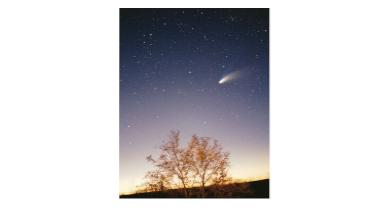Psalm 19:1
“The heavens declare the glory of God; and the firmament sheweth his handywork.”
 Few sights stick in my memory as much as that of seeing a comet. Beautiful astronomical objects, they glow like a celestial snowball with a large, magnificent tail.
Few sights stick in my memory as much as that of seeing a comet. Beautiful astronomical objects, they glow like a celestial snowball with a large, magnificent tail.
In fact, there are many comets in the sky every night, but usually they are too faint to see with the naked eye, and they may not have the characteristic tail. My most vivid memory of a comet was Comet Hale-Bopp in 1997, and I recall observing the comet after High School hours with a number of enthusiastic students during my time as a public school science teacher.
The tail is caused as the comet approaches the Sun. Material in the tail has evaporated from the comet, so the tail, therefore, points away from the Sun, not away from the direction of travel. This means that every time a comet passes the Sun, it loses some material. The amount and rate of loss show that it is not possible for a comet to survive millions of years.
Wikipedia confidently proclaims that short-period comets are formed in the Kuiper Belt, while long-period comets arise in the Oort Cloud. Yet the Kuiper Belt – a region of asteroids beyond the orbit of Neptune – does not show up any comet formation, while even the very existence of the Oort Cloud is in doubt.
No comet could be older than 100,000 years. Of course, they could be much younger. This is consistent with the biblical timescale of just over 6,000 years.
Prayer: Thank You, Lord, that when we examine science carefully, we find that it is consistent with Your word. Amen.
Author: Paul F. Taylor
Ref: Faulkner, D. (2012), Short-Lived Comets, < https://answersingenesis.org/astronomy/comets/8-short-lived-comets/ >, accessed 6/2/2020. Image: CC BY-SA 2.0 Austria.
© 2021 Creation Moments. All rights reserved.
